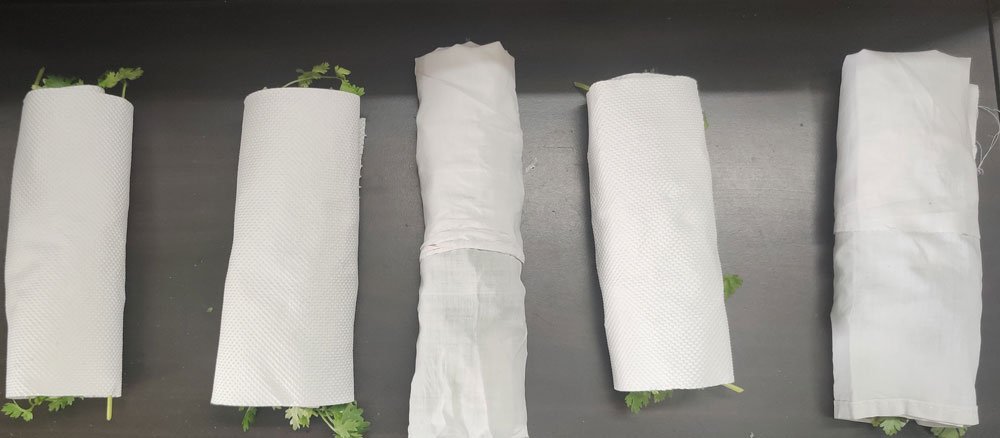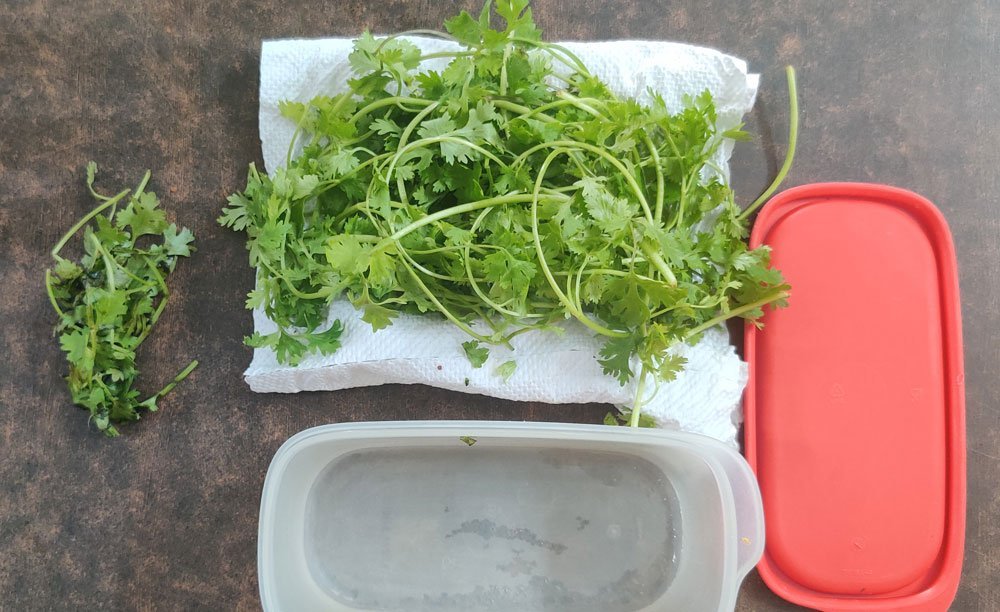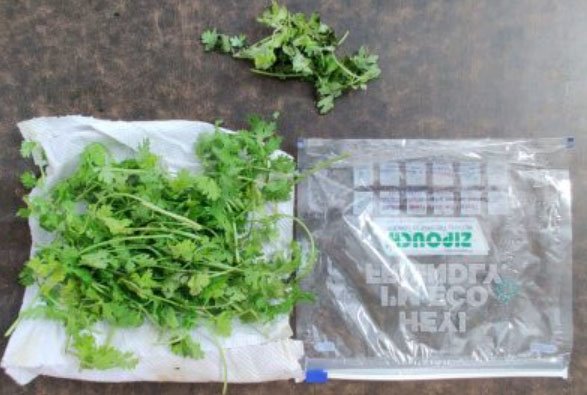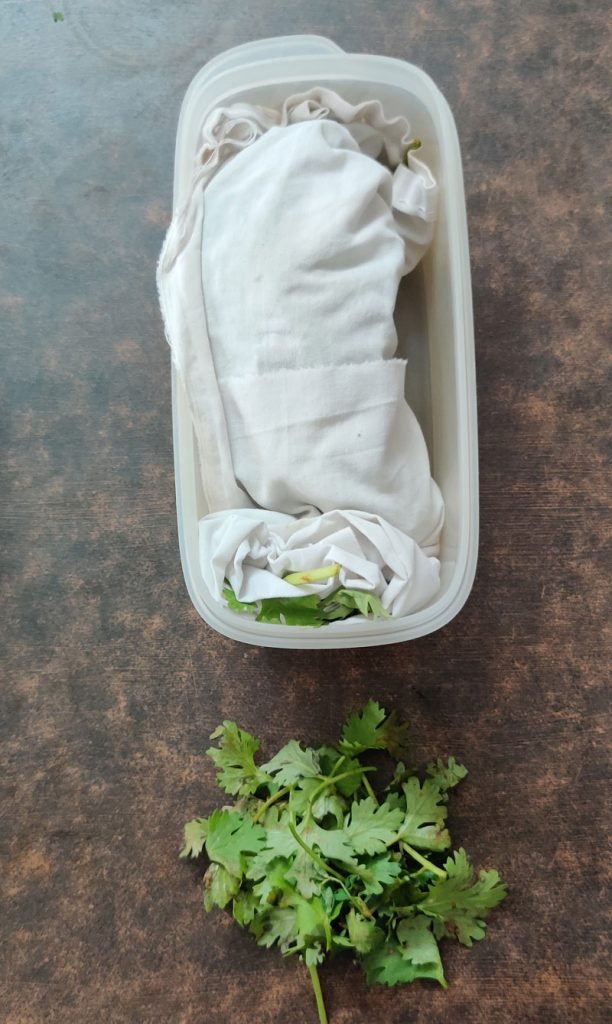If you often buy a large bunch of coriander leaves only to find it all sad and wilted by the time you use them, you are not alone. The key to preserving coriander leaves or any leafy vegetable for that matter is to maintain it at optimal humidity. Too dry and the leaves wilt away; too much moisture and it gets all soggy.
To maintain the equilibrium, you need to store them airtight so that the environment doesn’t get too dry. And to absorb the excess moisture you need to keep it covered in a paper or cotton towel. But which of these is effective? Ziplock cover? Container? Cotton towel or paper towel? To take the guesswork out of it, we tried them all to find which works the best.
The first step was to open the bunch and spread it on the countertop to remove any excess moisture and discard the yellow, wilted and soggy leaves. Then, we divided into 5 bunches of equal quantity.

We then spread the leaves on cotton towels/ paper napkins and wrapped them.

Spreading them is important to maximize the surface contact so as to absorb excess moisture uniformly. If you make a bunch first and then wrap it with a towel, the leaves in the middle will quickly get soggy.

After wrapping and keeping them in airtight containers and zip lock covers, we kept them in the crisper box in the fridge where the moisture level is moderate. We checked them after intervals of 1-2 weeks. In between, we changed the paper towel in one container after a week to see how it worked as well.
You may also like: How To Wash Pillows In Washing Machine
Method 1: Paper Towel In Plastic Container

After one week, we found that the paper towel was fairly moist. A few leaves were starting to turn brownish. But others were fairly well-preserved. Overall, this method looked quite promising.
But by the end of the second week, the paper towel was quite moist and a lot of the leaves had turned soggy. So, while this might be a good option to store coriander leaves for a week, we wouldn’t really recommend it if you want to preserve them for 2 weeks or more.

Method 2: Paper Towel In Ziplock Cover
Ziplock covers are not completely airtight. Some air seeps in through the interlocking grooves. After one week, many leaves had wilted and some turned downright mushy. Compared to the rest of the options, using paper towel in a Ziplock cover fared the worst.

Needless to say, by the end of the second week, there were even more soggy leaves. And a lot of leaves had turned yellow too. Overall, we wouldn’t really recommend ziplock covers for storing leafy vegetables.

Method 3: Cotton Towel in Plastic Container

As cotton towel absorbs more moisture, we found comparatively fewer soggy leaves after one week. But, many had turned brownish, probably due to the low moisture levels. The preserved leaves were pretty fresh.

However, by the end of the second week, the cotton towel was pretty moist. So, it didn’t prove much different from the paper towel. Here again, we had many soggy leaves, which meant this too isn’t an ideal solution when you need to store a large bunch for more than 2 weeks.
Method 4: Cotton Towel In Ziplock Cover
After one week, the cotton towel in the zip lock cover resulted in a few mushy leaves due to the high moisture level.

After 2 weeks, the towel was comparatively less moist as the zip lock cover provided some air circulation. Even so, there were a lot of wilted and mushy leaves. This too did not tick our checkboxes for an ideal storage solution for coriander leaves.

You may also like: How To Clean Burnt Utensil
Method 5: Paper Towel In Airtight Glass Container Changed Weekly
Glass containers are comparatively more airtight than plastic because plastic is slightly porous. When checked after a week, preserving coriander leaves in a glass container with paper towels turned out to be the best option so far. Only a few leaves were damaged and the rest of them were pretty good for use. At the end of the week, we changed the paper towel to see how it would affect the results after a week.

Even after the end of the second week, the leaves in the glass container was preserved the best. There were just a little bit of soggy leaves and the rest of them were comparatively fresher with very few turning yellow. Needless to say, it is the best solution for storing coriander leaves for 2 weeks or beyond.

Winner
At the end of the first week, we observed that airtight containers fared better than ziplock covers in preserving coriander leaves. So, if you want to preserve the leaves for just a week, you could use a paper towel and store them in either a glass or plastic airtight container. That being said, the glass did have an edge over plastic owing to lesser porosity.
But by the end of the second week, the glass container proved to be the clear winner. With a close-to-perfect airtight seal, it did not allow dry air from the refrigerator to seep in. So, there were minimal yellow leaves. As the paper towel was changed on a weekly basis, the excess moisture from the leaves was absorbed and it did not result in mushy leaves.
So, needless to say, it is the best option. So, if you need to store fresh leaves for a long duration, opt for airtight glass containers. The one we used is Borosil Klip N Store Glass Container. Even after 3 years of use, the silicone beading and the lock remain in mint condition.
Wrapping them in paper or cotton did not prove to be a differentiating factor. But, as mentioned, ensure that you spread the leaves on the towel and then wrap it to increase the surface area in contact. Also, change the paper towel or cotton cloth on a weekly basis. If you have a large quantity, you can also consider wrapping them in smaller bunches. Also, use an appropriately large glass container so that the leaves are not squished inside.

Whoever has done this research is a genius. I just love all your posts.
Thanks a lot Soneeta. This means a lot to us 🙂
very very useful.